Secret Kumari Kandam Continent And Links To Lemurians
A. Sutherland - AncientPages.com - A mysterious 'land along the mount Meru (Panmalaiyadukkam) submerged during the time of the destruction of Kumari Kandam. The land of Kumari Kandam was from the land stretch of Himalayas to the rule of South Kumari Kandam till the South Pole.
Kumari Kandam is a great mystery. It was the legendary sunken continent, mentioned in several works of Tamil literature and described in the Sanskrit literature.
- ‘This magnanimous landscape, from 30, 000 – 11, 000 B.C, at a snail's pace submerged in the seawater by different destructions like earthquakes, tsunamis, and volcanic eruptions.’ Each time the people escaped, they moved towards the North and North West regions and the east.
- ‘Hole in the Ozone was the reason for melted Icebergs,’
- Science accepts mentioning it as ‘40 – 400 meters of the high tide made the sea erosion.’
- The present land is the residue of the Sea level that went off after the ice age.
- It gave rise to new land regions and new nations including India, Australia, and Africa
Tamil continent Kumari Kandam - believed to be the connection between Africa to South India – was located in the Indian and Pacific Oceans, and has long been identified and closely associated with a hypothetical "lost land" of Lemuria.
Before submerging, Kumari Kandam lay to the south of India, approximately south of present-day town Kanniyakumari, in the state of Tamil Nadu.
It was ruled by Pandiyan Kings of an ancient Tamil dynasty for 10,000 years and was divided into 49 territories. ‘Silappadhikaram,’ one of the Five Great Epics of Tamil Literature written in 2nd century CE, confirms this catastrophic event and another ancient Tamil source gives the list of Pandiyan Kings who ruled the Kumari Kandam.
Tamil literature also says that over a period of about just 11,000 years, the Pandyans, a historical dynasty of Tamil kings, formed three Tamil Sangams, in order to foster among their subjects the love of knowledge, literature, and poetry, which became the most important basis of Tamil culture, protecting and perfecting the Tamil language and literature.
The first two Sangams were located in antediluvian Tamil land to the south, which in ancient times bore the name of Kumari Kandam, literally the ‘Land of the Virgin’ or ‘Virgin Continent’, (in Tamil, ‘Kumari’ means ‘pure/virgin’).
The First Sangam (probably about 9000 B.C) is described as having been held at the Pandiyan King’s capital city, to the south of Madurai, and the Pandyan king, Agastya, was the president of this Sangam until the city was lost in the sea.
There were 89 Pandiyan kings (decedents and rulers of that period) and this Sangam lasted 4440 years and had 549 members, which supposedly included some gods of the Hindu pantheon such as Siva, Kubera, the lord of riches and treasures, frequently mentioned in the epic ‘Ramayana’ and Murugan, the Commander-in-Chief of the army of the devas and the son of Shiva.
Due to this cataclysm, the king and all people who survived moved to the remaining land of Kumari Kandam and the king moved his capital to Kapatapuram. At the same time, the present location of Tamil Nadu was ruled by Chera, Chola, and 46 other small kingdoms.
The Second Sangam lasted for 3700 years and had 59 members, with 3700 poets participating. It was ruled by 59 Pandiyan kings. This city was sunken, too.
These tectonic processes played an important role in the disappearance of the ancient continent known as Lemuria to western scholars. Sri Lanka together with India, Indonesia, and Malaysia was a part of this continent.
Now, when Kumari Kandam was no more, the Pandiyan King seized the part of lands belonging to the kingdoms of Chola and Chera and established a seaport on the southernmost tip of the Indian Peninsula – Korkai. The city became the capital, which was later moved to the present-day city of Madurai.
The Third Sangam was supposedly located in the current city of Madurai, the then capital city of Pandiyan King, and lasted for 1850 years. There were 49 Pandiyan kings during this period. The academy had 49 members and 449 poets.
According to an Indian historian, K. K. Pillay (1905 – 1981). ‘it is important to observe that the Lemurian continent must have existed, if at all, long long ago. According to geologists, the dismemberment of the Lemurian or Gondwana continent into several units must have taken place towards the close of the Mesozoic era.’
"The equator regions have always been most prone to natural catastrophes like earthquakes and volcano eruptions... according to Professor Karsten M. Storetvedt, University of Bergen, Norway.
'...These tectonic processes played an important role in the disappearance of the ancient continent known as Lemuria to western scholars. Sri Lanka together with India, Indonesia, and Malaysia were a part of this continent. Many islands in the Pacific and Indian oceans are remnants of this continent that in ancient times covered the whole area of today’s ocean.
'...descriptions of cataclysms in early literature when land suddenly went underwater are logical. But they should be proven to be scientific facts. This can be done with the help of sea-floor analysis that is possible to carry out. Modern theories find supportive evidence both in ancient literature and language history...'
Written by – A. Sutherland AncientPages.com Staff Writer
Copyright © AncientPages.com All rights reserved. This material may not be published, broadcast, rewritten or redistributed in whole or part without the express written permission of AncientPages.com
Expand for referencesReferences:
D. Whittaker, The Lemurian Encyclopedia
Ma.So. Victor, The Submerged 'Kumari Continent'
More From Ancient Pages
-
 7,000-Year-Old Male Skeleton In Garment Decorated With Sea Shells, Red Deer Teeth Identified In France
Archaeology | Mar 9, 2017
7,000-Year-Old Male Skeleton In Garment Decorated With Sea Shells, Red Deer Teeth Identified In France
Archaeology | Mar 9, 2017 -
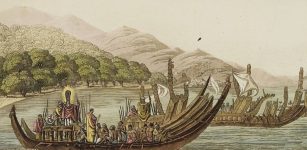 Binary System Was Used By Ancient Polynesians 1,000 Years Before The Concept Of A Computer Was Introduced
Ancient Technology | Feb 3, 2015
Binary System Was Used By Ancient Polynesians 1,000 Years Before The Concept Of A Computer Was Introduced
Ancient Technology | Feb 3, 2015 -
 Hundreds Of 19th-Century Skulls Collected In The Name Of Medical Science Tell A Story Of Who Mattered And Who Didn’t
Featured Stories | Nov 14, 2024
Hundreds Of 19th-Century Skulls Collected In The Name Of Medical Science Tell A Story Of Who Mattered And Who Didn’t
Featured Stories | Nov 14, 2024 -
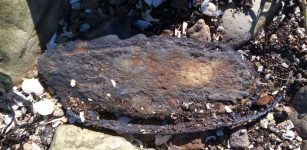 3,000-Year-Old Shoe Found On A Beach In Kent, UK
Archaeology | Feb 24, 2023
3,000-Year-Old Shoe Found On A Beach In Kent, UK
Archaeology | Feb 24, 2023 -
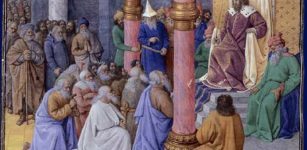 On This Day In History: Cyrus The Great Enters Capital Of Babylon And Allows Jews Return To Their Land – On Oct 29, 539 BC
News | Oct 29, 2016
On This Day In History: Cyrus The Great Enters Capital Of Babylon And Allows Jews Return To Their Land – On Oct 29, 539 BC
News | Oct 29, 2016 -
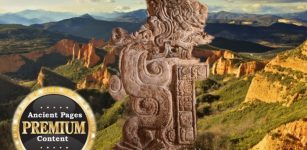 Mysterious Ancient European Civilization – Puzzling North American Connection – Part 1
Civilizations | Oct 21, 2019
Mysterious Ancient European Civilization – Puzzling North American Connection – Part 1
Civilizations | Oct 21, 2019 -
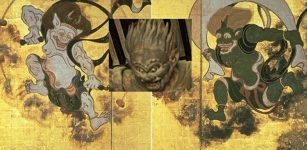 Raijin: Shinto God Of Thunder And Lightning With Three Fingers Representing Past, Present And Future
Featured Stories | Feb 10, 2020
Raijin: Shinto God Of Thunder And Lightning With Three Fingers Representing Past, Present And Future
Featured Stories | Feb 10, 2020 -
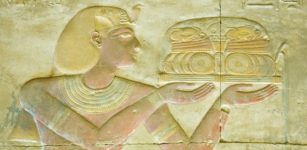 Table Manners And First Code Of Correct Behavior Were Introduced In Egypt 2,500 B.C. By Ptahhotep
Ancient History Facts | Oct 26, 2020
Table Manners And First Code Of Correct Behavior Were Introduced In Egypt 2,500 B.C. By Ptahhotep
Ancient History Facts | Oct 26, 2020 -
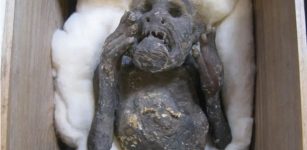 Mystery Of The ‘Mummified Mermaid’ In Japan Solved!
News | Feb 19, 2023
Mystery Of The ‘Mummified Mermaid’ In Japan Solved!
News | Feb 19, 2023 -
 Ullikummi – Genderless, Blind, Deaf Rock Monster Created For Strategic Purposes In Beliefs Of Hurrian People
Featured Stories | Sep 3, 2024
Ullikummi – Genderless, Blind, Deaf Rock Monster Created For Strategic Purposes In Beliefs Of Hurrian People
Featured Stories | Sep 3, 2024 -
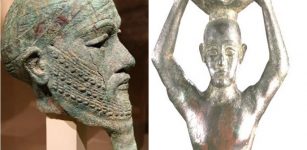 King Ur-Nammu – King Of Ur, King Of Sumer And Akkad – The One Who Built The Temple Of God Enlil
Ancient History Facts | Aug 30, 2015
King Ur-Nammu – King Of Ur, King Of Sumer And Akkad – The One Who Built The Temple Of God Enlil
Ancient History Facts | Aug 30, 2015 -
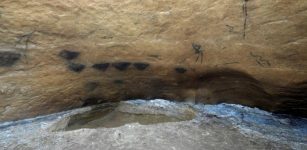 Cave Art In ‘Painting Room’ – At Ojo Guareña (Burgos) Is Over 12,000 Years Old
News | Oct 2, 2020
Cave Art In ‘Painting Room’ – At Ojo Guareña (Burgos) Is Over 12,000 Years Old
News | Oct 2, 2020 -
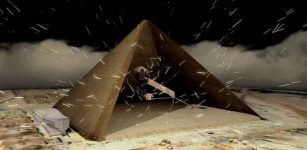 New Cosmic Ray Bombardment Of The Great Pyramid – Search For The Hidden Chamber Continues
Archaeology | Jan 20, 2020
New Cosmic Ray Bombardment Of The Great Pyramid – Search For The Hidden Chamber Continues
Archaeology | Jan 20, 2020 -
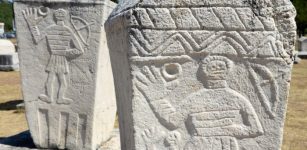 Enigmatic ‘Stone Sleepers’ – Megalithic Tombstones ‘Stecci’ In The Western Balkans
Civilizations | Dec 3, 2018
Enigmatic ‘Stone Sleepers’ – Megalithic Tombstones ‘Stecci’ In The Western Balkans
Civilizations | Dec 3, 2018 -
 Beware Of The Shapeshifting Gaelic Bodach Who May Be Difficult To Trick
Christmas Traditions | Dec 3, 2021
Beware Of The Shapeshifting Gaelic Bodach Who May Be Difficult To Trick
Christmas Traditions | Dec 3, 2021 -
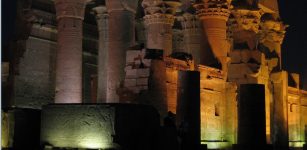 Two Discoveries Reported From Komombo Temple And Elephantine Island, Aswan
Archaeology | Dec 9, 2017
Two Discoveries Reported From Komombo Temple And Elephantine Island, Aswan
Archaeology | Dec 9, 2017 -
 New Details On Neanderthals – Revealed By Museum Exhibition In Norway
Archaeology | Jun 16, 2023
New Details On Neanderthals – Revealed By Museum Exhibition In Norway
Archaeology | Jun 16, 2023 -
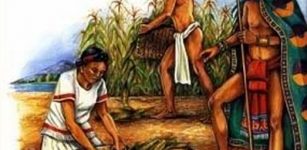 Slaves In The Aztec Empire Had Much Better Rights Than In Any Other Ancient Society
Ancient History Facts | Jul 6, 2016
Slaves In The Aztec Empire Had Much Better Rights Than In Any Other Ancient Society
Ancient History Facts | Jul 6, 2016 -
 Queen Teuta: Power-Hungry Villain Who Underestimated The Romans
Featured Stories | Oct 31, 2019
Queen Teuta: Power-Hungry Villain Who Underestimated The Romans
Featured Stories | Oct 31, 2019 -
 What Female Jobs Could Lead To Being Accused Of Witchcraft In Early Modern England?
News | Sep 20, 2023
What Female Jobs Could Lead To Being Accused Of Witchcraft In Early Modern England?
News | Sep 20, 2023



